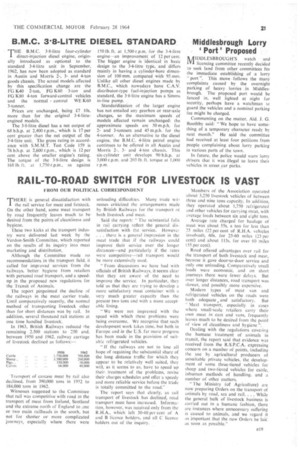RAIL-TO-ROAD SWITCH FOR LIVESTOCK IS VAST
Page 25

If you've noticed an error in this article please click here to report it so we can fix it.
FROM OUR POLITICAL CORRESPONDENT
THERE is general dissatisfaction with
the rail service for meat and fatstock. On the other hand, some meat transport by road frequently leaves much to be desired from the points of cleanliness and hygiene.
These two kicks at the transport industry were delivered last week by the Vcrdon-Smith Committee, which reported on the results of its inquiry into meat marketing and distribution.
Although the Committee made no recommendations in the transport field. it called for improved services from the railways, better hygiene from retailers with personal road transport, and a speedup in the proposed new regulations for the Transit of Animals.
The report pinpointed the decline of the railways in the meat carrier trade. Until comparatively recently, the normal method of transporting livestock other than for short distances was by rail. In addition, several thousand rail stations at one time handled livestock.
In 1963, British Railways reduced the remaining 2.500 stations to 250 and, between 1950 and 1962. railway carriage of livestock declined as -follows:—
1950 062
Call It 1.750,000 700,000
Sheep.. 3.500,000 260,000 330,000 50,000 Calves 64,000 40,000
Transport of carcase meat by rail also declined, from 390,000 tons in 1952 to 184,000 tons in 1962.
Witnesses suggested to the Committee that rail was competitive with road in the transport of meat from Ireland, Scotland and the extreme north of England to one or two main railheads in the south, but not for shorter ormore complicated journeys, especially where there were
unloading difficulties. Many trade wit nesses criticized the arrangements made by British Railways for the transport of both livestock and meat.
Said the report: "The substantial falls in rail carrying reflect the general dissatisfaction with the service. However . . there is a general impression in the meat trade that if the railways could improve their service over the longer distances:—and particularly if the rates were competitive—rail transport would be more extensively used.
" From discussions we have had with officials of British Railways, it seems clear that they are aware of the need to improve the service. In particular, they told us that they are trying to develop a more satisfactory meat container with a very much greater capacity than the present two tons and with a more acceptable lining.
" We were not impressed with the speed with which these problems were being overcome. We recognise that such development work takes time, but both in Europe and in the U.S. far more progress has been made in the provision of suitable refrigerated vehicles.
" If the railways are not to lose all hope of regaining the substantial share of the long distance traffic for Which they appear to be relatively well suited, they will, as it seems to us, have to speed up their treatment of the problems, revise their charges schedules and offer a speedy and more reliable service before the trade is totally committed to the road."
The report says that clearly, as rail transport of livestock has declined, road transport must have increased. Information, however, was received only from the R.H.A., which left 30-40 per cent of A and B licence holders, and all C licence holders out of the inquiry. Members of the Association operated about 3,250 livestock vehicles of between three and nine tons capacity. In addition, they operated about 1,750 refrigerated and other vehicles for carrying meat, with average loads between six and e:ght tons.
Average rate charged for haulage of ineat was about 55s. a ton for less than 25 miles (22 per cent of R.H.A. vehicles involved), 60s. for 25-60 miles (23 per cent) and about 115s. for over 60 miles (55 per cent).
Road offered advantages over rail for the transport of both livestock and meat, because it gave door-to-door service and only one unloading. Comparatively small loads were economic, and on short journeys there werefewer delays. But over longer distances, road transport was slower, and possibly more expensive.
Modern types of meat van and refrigerated vehicles on the roads were both adequate. and satisfactory. But
Meat transport, especially in cases where small-scale retailers carry their own meat in cars and vans, frequently leaves much to be desired from the point of view of cleanliness and hygiene ".
Dealing with the regulations covering the humane treatment of animals in transit, the report said that evidence was received from the R.S.P.C.A. expressing concern on a number of points, including the use by agricultural producers of unsuitable private vehicles, the development of some three-tiered vehicles for sheep and two-tiered vehicles for cattle, inhuman methods of handling, and a number or other matters.
The Ministry (of Agriculture) are now preparing Orders on the transport of animals by road, sea and rail... . While the general bulk of livestock business is carried out in a humane fashion, there are instances where unnecessary suffering is caused to animals, and we regard if as important that the new Orders be iAie as soon as possible."












































































































